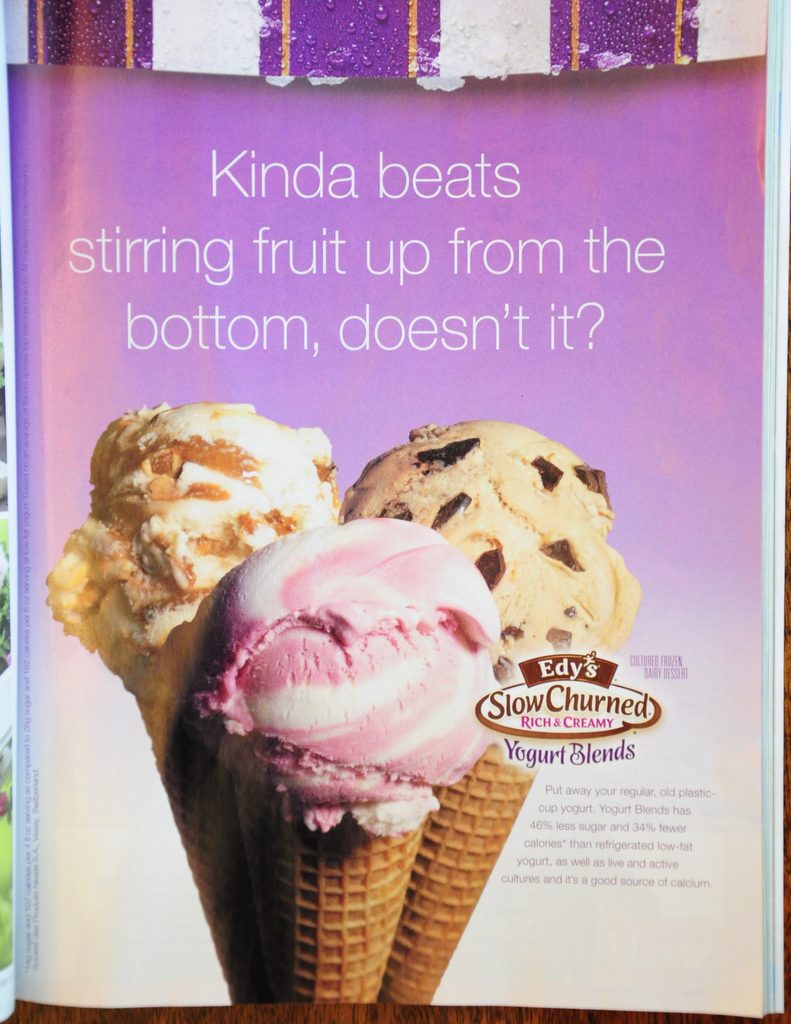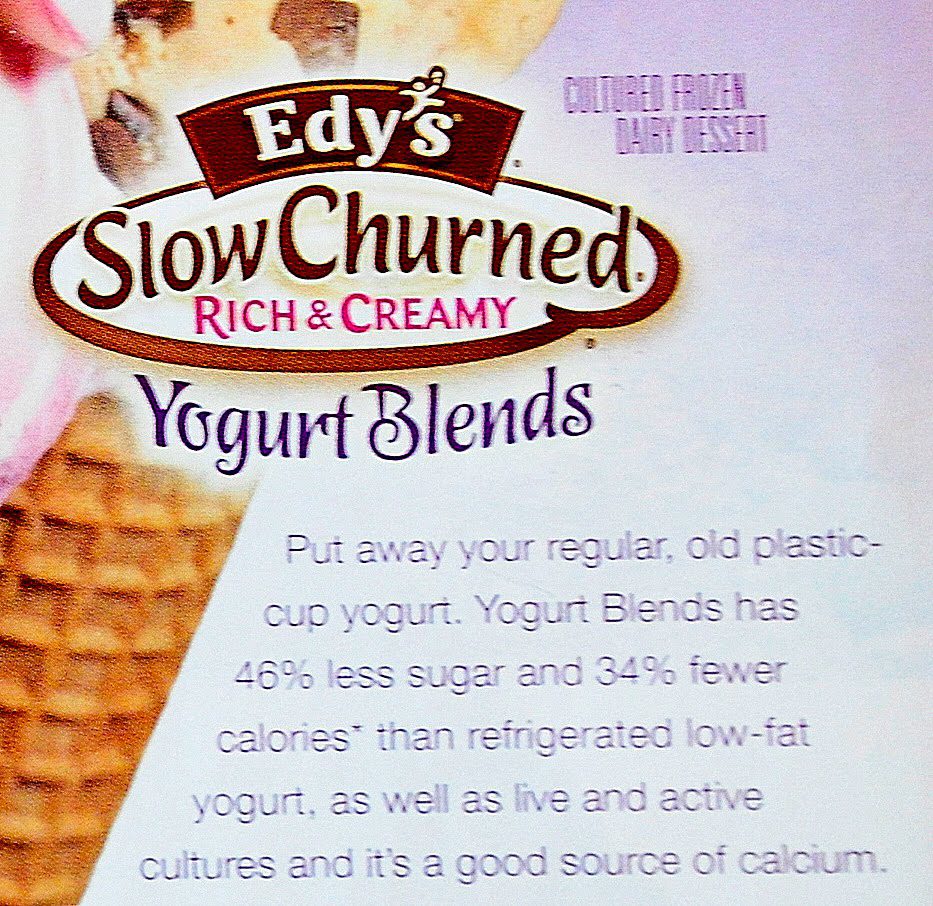Today’s post recalls my 2009 post, “Frozen Yogurt FAIL: What a Bad Consumer Experience Taught Me about Retaining Members in the Church.’ That same year I encountered another “frozen yogurt fail” that I’ve been meaning to share. Now that I’m in Shanghai, on hot days (as in most days) my thoughts more frequently turn to the abundant frozen yogurt here in the land of mostly melamine-free milk and honey. By the way, I’m pleasantly surprised at how much milk and yogurt there is in this allegedly lactose intolerant nation, and hope that lactose and religion will continue to advance on the toleration front.
So here’s the “FAIL” part of the story. Edy’s Ice Cream had a lovely full-page ad in Better Homes and Gardens in 2009 (I believe it was June 2009 – that’s when I took the photos). The ad touted the advantages of Edy’s frozen yogurt over regular refrigerated yogurt:
Put away your regular, old plastic-cup yogurt. Yogurt Blends has 46% less sugar and 34% fewer calories* than refrigerated low-fat yogurt….
Wow, frozen yogurt has 34% fewer calories? What amazing technology did the food scientists at Nestle invent to do that? Mmmm, the invention wasn’t by the scientists–it’s an invention of marketing. Look at the fine print in the hard-to-see side of the ad. If you don’t flatten the magazine out, you wouldn’t even see the footnote:
14 g sugar and 107 calories per 4 fl oz serving as compared to 26 g sugar and 162 calories per 6 ounce serving of low-fat yogurt.
Whoa, mama! You mean you’re comparing 4 ounces of your product to 6 ounces of the competitors’ product, and boasting about how your tiny serving size has fewer calories than the bigger size serving of regular yogurt? Why not compare 1 gram of the good stuff to a million grams of the bad ol’ competitive stuff and claim you’re a million times better? Or would that be too obvious?
Here’s the footnote: click to enlarge.
So let’s see, if we compare a 6-ounce serving of frozen yogurt to a 6-ounce serving of regular yogurt, things are a little less impressive on the calorie front. Turn’s out 6 ounces of Edy’s frozen yogurt has 161 calories (160.5 if you don’t round). That’s a tad less than the 162 calories of evil regular yogurt, but not enough to avoid my FAIL award. There appears to be less sugar, with 21 g in Edy’s versus 26 g in regular yogurt. Less sugar but the same calories? Bet it’s the extra fat in Edy’s making the difference, but the marketers don’t seem anxious to discuss that part of the story.
Edy’s applied an advanced technology to turn their high-fat product with the same calories as regular yogurt into a healthy marvel with 34% fewer calories. The most cutting-edge version of this technology is, of course, found at WonderWhacker.com, where we can learn more about what leading experts call GAVROES, short for “Gravimetric and Volumetric Reallocation of Existential Substance.” The WonderWhacker website may be a bit too advanced, but in layman’s terms, if you take one portion of food and whack it with WonderWhacker technology, you can get two portions, each new portion now having approximately half the calories and half the fat that the single portion had before! Nestle hasn’t upgraded their technology to be able to reduce fat as effectively as the folks at WonderWhacker.com can, but I’m sure that’s in the works.
Wait, this is a blog about religion? Oh, right. Well, the point is that statistics can tell some pretty crazy stories sometimes, especially when they are being used for marketing and not for understanding. Some hostile “marketers” love to throw statistics out the same way they throw out horrifying snippets about our bizarre beliefs, not to promote understanding but to quickly score emotional points to sell their point of view. A popular approach is to find social problems in Utah and suggest that the religion is responsible and, therefore, that the religion is bad or harmful. Utah is not paradise (you have to come over here to China for that, I’m afraid) and has plenty of problems, but linking those to the Church may be quite a stretch sometimes.
Improper bases for comparison can lead to errant conclusions in some of these drive-by-statistics cases. For example, in terms of suicide statistics for Utah, one seeking to understand might want to look at Utah stats versus the Mountain West in case to consider the impact of Western US culture. One looking at anti-depressant use in Utah might do several things to understand what it means and consider a variety of complex factors before jumping to rash conclusions. One troubled by the high consumption rate of green jello in Utah can also recognize, that, uh, I mean, because maybe, uh … OK, that is just plain troubling. Sorry. But it’s not necessarily the Church’s fault.
Be careful when dealing with the tiny bit of information contained in a statistical snippet. Swallowing those stats like a plate full of green jello may not be the healthiest thing for you.














There's another statistic promoted by the LDS church that there are over 10 million members.
BYU Law Professor, Frederick Gedicks, claims that as many people join the church as leave it: "Anyone who's served a recent mission in Europe knows that the Church is struggling to maintain a demographic peak in those countries that was never very high. Church membership has rarely exceeded one-tenth of one percent of the population of any European country. And even in the United Kingdom, where the Church has a long historical presence, Mormons constitute only three-tenths of one percent of the population.
Now church membership, of course, is much stronger in the United States, Mormons make up about 2% of the US population, and there are notable concentrations in California, Utah and other states in the interior west. But even here there are disquieting signs of the challenges we face as a church:
membership growth in the United States has been flat during the last decade;
independent survey evidence shows that about as many people leave the church now as join it each year;
convert baptisms have been declining during this period…"
And other estimates drive the number down to about half of what the church claims.
It reminds me of the quote, "He uses statistics as a drunken man uses lamp-posts…for support rather than illumination."
Actually, everyone who joins the Church leaves it, eventually, dead or alive.
Most who "leave" it while alive are still on the records, though, and just quit coming. About half of the Church is "less active" in typical U.S. wards, but they are still members, and some of them eventually return, as did one of the best church leaders in my former region of Wisconsin and many other great people I've known, and some of the best Mormons I know are non-attenders who are still full of faith and love for the Kingdom of God and serve others, pray, and read the scriptures, but don't attend for various personal reasons. They and I consider them Mormons as well.
When someone has their name removed from the records or is excommunicated, they are no longer counted as members of the Church. I don't see how the Church can reasonable report its numbers any other way, except to add average sacrament meeting statistics or other stats that don't reflect Church membership either because people miss Church for all sorts of reasons other than rejecting their membership in it.
When I teach my students, we talk about "ecological fallacies" and that seems to be what you are referencing. An ecological fallacy occurs when one erroneously draws conclusions about individuals based solely on the observation of or gathering of data from groups. The example I use for my class is suicide rates in two countries. We could collect data in the aggregate for suicide rates in Great Britain, a predominantly Protestant country, and find that they are much higher than suicide rates in Italy, which is predominantly Catholic. We might mistakenly conclude that suicide rates are higher in Great Britain precisely b/c it is Protestant. Of course, the problem is that we don't know the specific religion of those who committed suicide b/c we didn't gather data at the individual level. I see these kinds of reports all the time and shake my head.
I am interested in getting my name removed from the records. I don't consider myself a mormon and have concerns over some of the teachings of Joseph Smith.
Fortunately its been about 3 years since I last went to a ward meeting and the phone calls and letters have slowed to just a few a year.
I am attending another church every sunday and as far as my relationship with Jesus some months I'm better than others. Its a constant work in progress.
I'm sure LDS will say I'm rejecting Jesus by wanting to leave but its actually me rejecting the views of the LDS church only. I'm also sure LDS views this as me not being 'eligible' to go to the highest level of heaven but I would rather let Jesus decide that than my name in some database in Utah.
Initially I started my path out of LDS with hurt and anger. Seeing the LDS past, LDS teachings etc. After all these years I'm just to the point where I want to leave in a peaceful manner without everyone getting upset.
I don't deny Jesus in any way. Jesus is the Christ.
Thanks
Wonder what the independent surveys were talking about, then. I wonder if the BYU Law Professor considered whether "leave" was defined as a sort of absence or if they only counted those who claimed to no longer be Mormon.
There are other ways the numbers could be buffed, though. Not all exmormons come out and claim their beliefs–be it out of apathy, fear of rejection, or, especially, fear of losing their marriage.
My experience with people in this country and in Europe suggests that religion plays an increasingly small part, if any, in their lives, regardless of denomination. Being an agnostic or Atheist is more and more the norm, it appears. Depending on the study you wish to read, church attendance and activity is down across the board. Some studies conflict with one another, of course.
My point is that the decline in attendance and activity is universal, across the board, and not merely endemic to the Latter Day Saints.
BTW, I was inactive for the better part of a decade, and have just recently come back to the Church. I couldn't be happier with that. Interesting to note that our current Elders Quorum President has been back now for two years after having asked to have his records removed from the Church.
People tend to connect anything that happens in Utah with Mormons because they are so predominant throughout the state. Also, statistics don't lie, but you can lie very well with statistics.
New (additional) LDS stakes and congregations are being created all across the US, and new (additional, not just replacement) chapels are being built.
So whatever the percentage of Mormons who are "active" is, the overall number of Mormons who are sitting in the pews Sunday keeps increasing, both in the US and in other countries.
Rates of inactivity are higher outside the US, but the organizational trend and the construction trend still holds: new branches, wards, and stakes continue to be created.
So while the snarkers like to point out that some people officially leave the church, and inactivity rates increase, they are missing the bigger picture:
1. The active membership is still growing in numbers, among those born-in-the-church and among converts. Both of those groups are increasing in numbers.
2. The organization structure is growing, with new branches, wards, and stakes.
3. The number of chapels and temples is growing.
4. The church is establishing a presence in more and more places.
5. More and more non-members are being exposed to the LDS gospel.